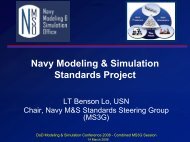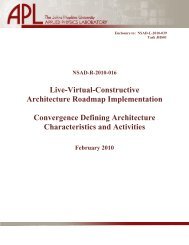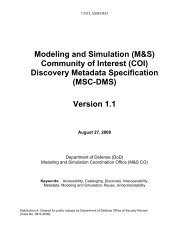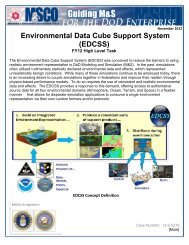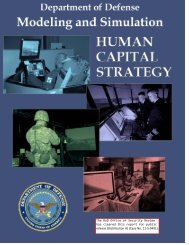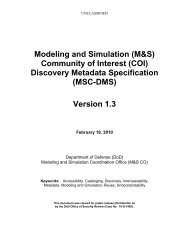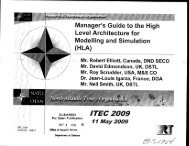LVCAR-I Convergence Final Report - Modeling & Simulation ...
LVCAR-I Convergence Final Report - Modeling & Simulation ...
LVCAR-I Convergence Final Report - Modeling & Simulation ...
You also want an ePaper? Increase the reach of your titles
YUMPU automatically turns print PDFs into web optimized ePapers that Google loves.
Live-Virtual-Constructive Architecture Roadmap Implementation,<br />
<strong>Convergence</strong> <strong>Final</strong> <strong>Report</strong><br />
CTIA-to-CSI coupler provides a translation between the CSI functionality and the existing CTIA<br />
Services IDL. If changes to the CTIA Services IDL are required, the architects can use the CTIA<br />
AWG forum to request the change.<br />
3.2.2 CTIA Interactions<br />
The message constructs of CTIA are defined by the CTIA data model. Some extension to<br />
support general object models could be made. The architects need to create a CTIA-to-ANDEM<br />
transform that provides an interface between the ANDEM objects and the CTIA Object Model.<br />
The CTIA-to-ANDEM transform provides a mapping between the ANDEM objects and the<br />
existing CTIA Object Model. If changes to the CTIA Object Model are required, the architects<br />
can use the CTIA AWG forum to request the change.<br />
The architects also need to create a CTIA-to-CSI coupler that provides an interface that<br />
allows the objects used within the CTIA data model to be declared as objects within the<br />
converged federation LVC exercise. The CTIA-to-CSI coupler provides a translation between<br />
the CSI functionality and the existing CTIA Services IDL. If changes to the CTIA Services IDL<br />
are required, the architects can use the CTIA AWG forum to request the change.<br />
3.2.3 CTIA Transfer of Ownership<br />
The CTIA notion of ownership is static. Support for ownership transfers has been done<br />
on a case-by-case basis to support live player rest periods. CTIA needs to (1) add capability to<br />
transfer “ownership” between live player and simulation and (2) allow attribute update from an<br />
external source. The architects need to perform a functional thread analysis to articulate one or<br />
more use case scenarios that describe the conditions under which transfer of object ownership<br />
would occur. Each use case scenario can be decomposed to identify the (1) user interaction with<br />
the system; (2) interactions between components; (3) expected capabilities (i.e., inputs, outputs,<br />
functions, and constraints); (4) sequence diagram details; (5) description of the data elements to<br />
be exchanged; and (6) relevant system design decisions and associated decision rationale. Once<br />
the thread analysis is complete, the architects should create a more detailed plan for implemented<br />
the ownership transfer capability within CTIA in coordination with the CTIA AWG.<br />
3.3 DISTRIBUTED INTERACTIVE SIMULATION (DIS)<br />
DIS uses a wire protocol, standardized in Institute of Electrical and Electronics Engineers<br />
(IEEE) standard 1278.1 [DIS Committee of the IEEE Computer Society, 1995] and IEEE<br />
standard 1278.1a [DIS Committee of the IEEE Computer Society, 1998] that allows<br />
interoperability between real-time simulations of weapons platforms. DIS is a network protocol<br />
with hundreds of implementations. Therefore, it is unreasonable that every implementation<br />
would be expected to be redesigned to use the CSI, as is hoped for the standard implementations<br />
of other architectures. As shown in Figure 3, DIS will require an additional gateway computer to<br />
host the CSI and coupler for DIS. The responsibility for DIS convergence must be shared<br />
Page 15



